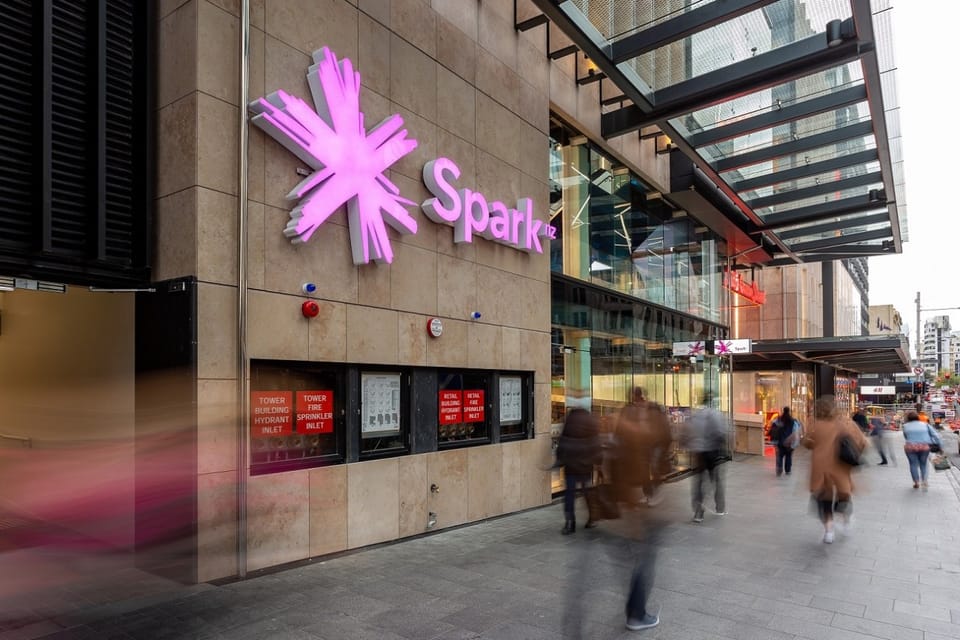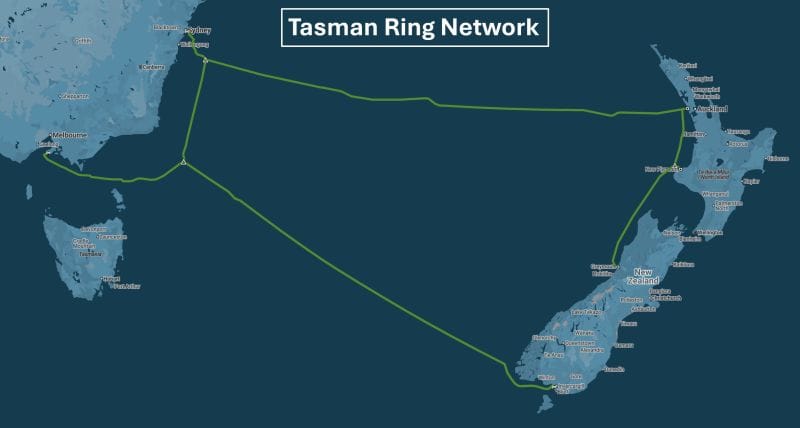Spark profit falls as company shifts back to core

In this newsletter:
- Spark outlines new strategy focusing on core business
- ComCom recommends deregulation of rural copper network
- Tasman-Ring names submarine routes
Challenging period sees Spark profit plunge
Spark’s profit dropped by a third after the company faced what chair Justine Smyth describes as “one of the most challenging periods in its history”.
While the company’s reported net profit came in at $260m, Spark’s adjusted net profit was just $227m, a drop of 33.6 percent on last year’s $316m.
Exceptional circumstances mean Spark offers two parallel sets of figures for the 2025 financial year. Reported numbers exclude the data centre business while adjusted numbers include the data centre business but exclude one-off costs.
The company says the adjusted figures give a better comparison with the 2024 financial year.
Headline figures:
| Reported 2025 | Adjusted 2025 | 2024 | |
|---|---|---|---|
| Net profit | $260m | $227m | $316m |
| Revenue | $3,725m | $3,700m | $3,685m |
| EBITDAI | $1,053m | $1,060m | $1,160m |
Smyth says the company: “Navigated economic headwinds, materially lower customer spending, and ongoing structural change in some of our markets”.
She reassured investors saying the company has made good progress since announcing a transformation programme at Spark’s November 2024 AGM. “We have made good progress since that time. We undertook a strategic review of non-core assets to recycle capital into our core business and reduce net debt. This culminated in the sale of our remaining stakes in Connexa and Hutchison Telecommunications (Australia) Limited, delivering combined proceeds of $356 million.
Five year back to core plan
Smyth outlined a new five year strategy to take the company back to its core telecommunications business and further from its earlier move into digital services.
While it has been a tough year for Spark, the business has not deteriorated since poor half year results were announced in February and first flagged last November.
There are bright spots: Mobile revenue fell by just 2.3 percent to $987m in a difficult market. This can be read as a sign the business is stabilising and is important given the back to core business plan.
Spark blames the mobile revenue decline on intense price competition in key markets and a one-off removal of an insurance product in consumer pay monthly services. The company says this will not reoccur next year.
Meanwhile, consumer and small business monthly connections grew. Once the insurance impact is accounted for, the second half average revenue per customer increased by around three percent.
Spark’s broadband revenue stabilised, with a small decline over the year of 0.8 percent to $608 million.
Core connectivity
CEO Jolie Hodson says the company has taken: “decisive action to transform our business and cost base, with a particular focus on our core business of connectivity.
“Our connectivity products and solutions account for 80 percent of gross margins and given the scale of our mobile business it is our number one priority. While our overall mobile service revenue declined during FY25, performance is stabilising and improving into FY26. We remain market leader by some distance.
“In our largest mobile segment, consumer pay-monthly, connections and underlying ARPU are growing. The mobile fleet reduction we experienced as businesses and government reduced workforces over the last year has now stabilised. We were also pleased to retain over 95 percent of our top 50 business customers, demonstrating the strength of our competitive advantage in the market.”
ComCom recommends rural copper deregulation
As flagged earlier this year, the Commerce Commission has made its final decision that rural copper can safely be deregulated. It has passed its recommendation to Paul Goldsmith, the Minister for Media and Communication.
While the decision rests with the minister, it would be unusual if deregulation did not go ahead.
Telecommunications Commissioner Tristan Gilbertson says copper regulation is no longer needed to promote competition as technology has transformed rural connectivity over the past two decades.
Rural concerns remain
Despite this, speakers at this year’s Tuanz Connecting Aotearoa Summit expressed concerns about the removal of rural copper services.
Yet, the number of rural customers still using copper has fallen dramatically in recent years. Chorus says copper connections have declined by 95 percent. There are few places where people don’t have better alternatives.
Gilbertson says: “Most rural consumers can now access three alternative technologies that are often more affordable, better performing, and more reliable than copper”.
Chorus notes decision brings clarity
Chorus has been keen to see the end of rural copper and welcomed the recommendation.
The fibre wholesaler’s general counsel, Kristel McMeekin, says the technology is nearing the end of its useful life and the recommendation: “Provides clarity for consumers and industry, and sets a clear path forward for copper retirement.”
New Zealand’s move to retire copper networks is in line with international practice
McMeekin says her company acknowledges the importance of copper to those who still use it and is working closely with the Commerce Commission, government and retail service providers to ensure a clear process for copper retirement is in place as soon as possible: “We are committed to ensuring a smooth transition to better, more reliable and fit for future technologies”.
Tasman Ring adds Invercargill-Melbourne submarine cable

Datagrid and Tasman Ring founder Rémi Galasso used a Linkedin post to announce the completion of the Tasman Ring Network desktop study. He says a new submarine route between Invercargill and Melbourne has been validated and will offer the lowest latency connection to New Zealand's South Island.
The study confirmed plans for a route down the West Coast of New Zealand connecting the North and South islands withy landings at New Plymouth and Greymouth. This will improve resiliency of domestic and international connections. The project has also identified a new landing site in Melbourne away from existing routes.
In other news
- 2degrees moves all its customers onto one database — Reseller News
- New Zealand doesn’t get a right to repair — Interest
- Streaming service winners and losers — NZ Herald

Oppo launches $500 tablet
Oppo’s NZ$500 Pad SE is a lower-priced Android tablet designed to handle basic tasks, video streaming and less demanding games. It’s the kind of device that can get family members online for homework without breaking the bank. Oppo describes it as durable and says the battery is good for 11 hours of video or up to 80 hours of music.
InternetNZ adds satellite to its broadband map
This week’s InternetNZ dotNews newsletter says the organisation has added satellite internet coverage to its broadband map. For now this would be all of New Zealand, although at times new connections are not available in some areas because of congestion. The map lets people check services available at any address in New Zealand.
Five years ago: Vocus NZ outperforming Australian parent
Vocus New Zealand revenue was up five percent in the 2020 financial year while the Australian telco's group revenue dropped six percent. SamKnows, which was in the early stages of working on the Commerce Commission Measuring Broadband report, discovered prime time speed drops for customers on Fibre Max Plans. Infrastructure Minister Shane Jones announced funds for two Chorus regional fibre links in the South Island.
One year ago: ComCom trims Chorus spending plan
The Commerce Commission gave Chorus the green light to invest $1.7 billion over the next four years, but cut $172 million from the fibre company’s submitted plan. Five years ago we were concerned about the bias in algorithms.
Share Download Weekly — Feel free to pass this email on to your colleagues.
Have your say. Subscribers, it's free and we don’t collect any data, can comment on any newsletter or story on the website. Just scroll to the bottom of the page. Reader emails are also welcome.
Member discussion